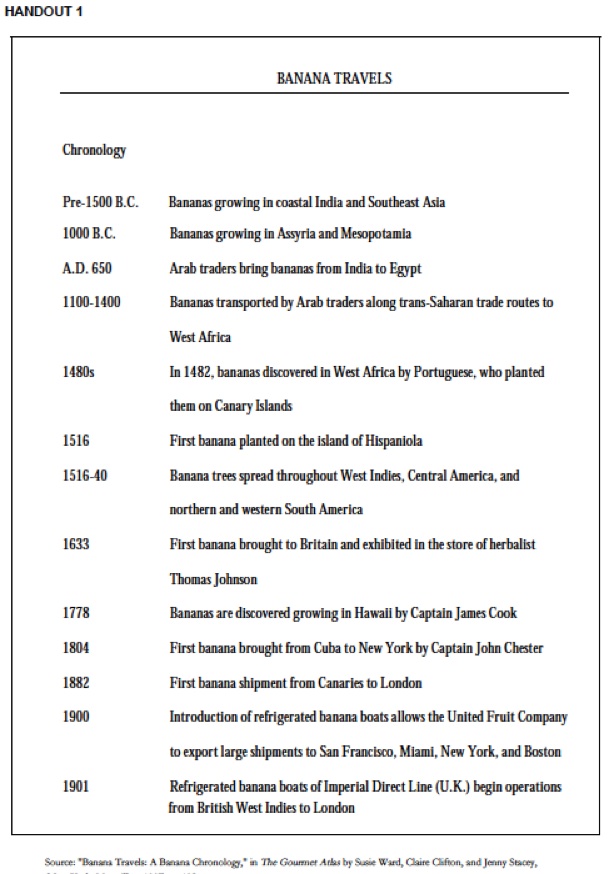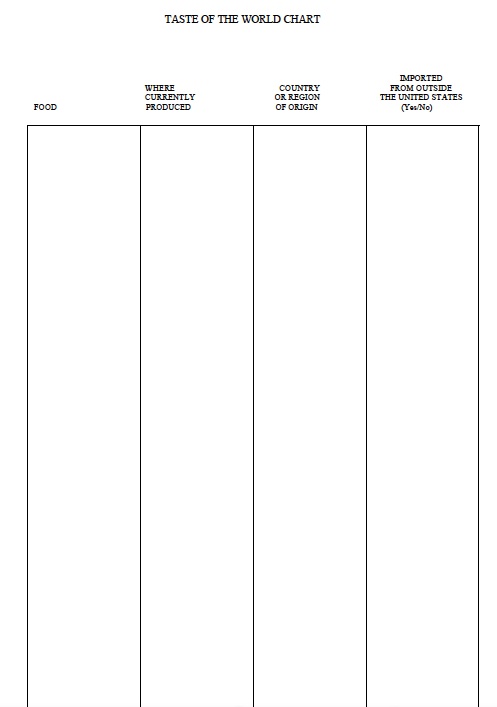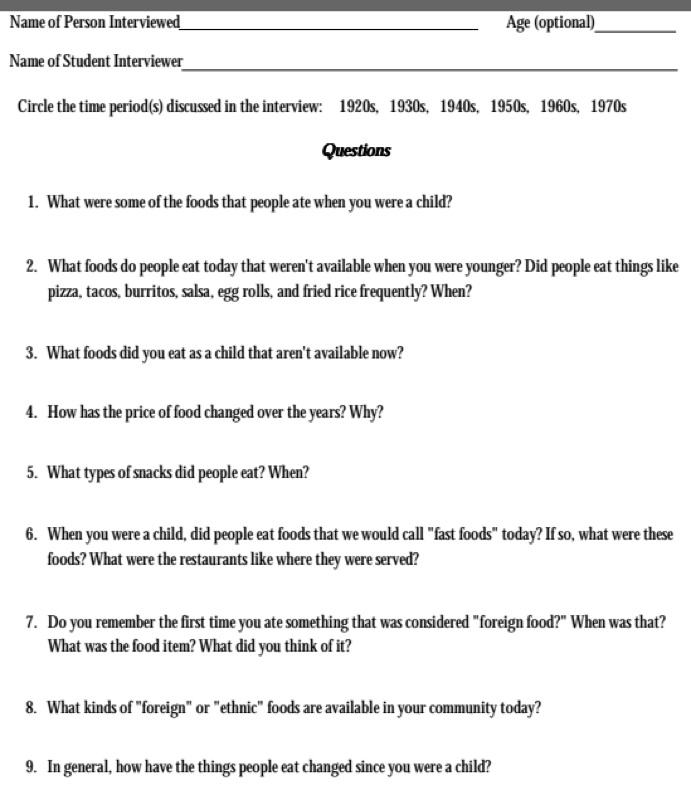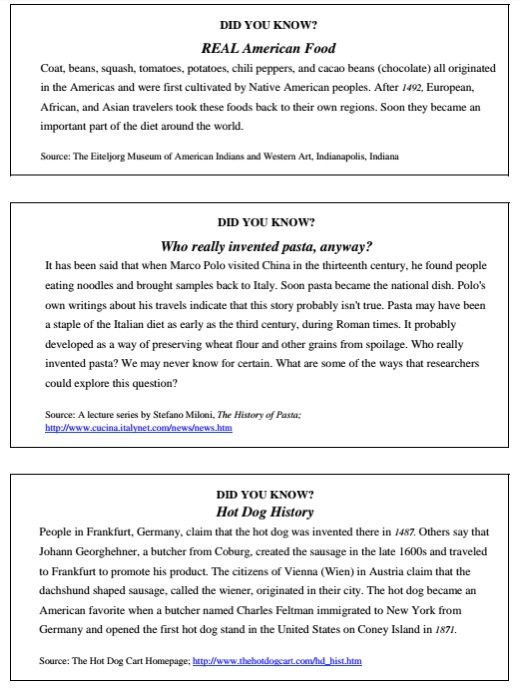Taste the World

INTRODUCTION
This unit explores a number of ways that students and the community they live in are linked to the world. Most students are unaware of the richness of their own community's past and the complexity of its present international connections. To introduce students to these ideas, the unit begins with one of the basic necessities of daily life, food. Students have the opportunity to examine how the types of food we eat have become more international over time as a result of specialization, interdependence, and globalization. In subsequent lessons, students explore their community's ethnic and cultural history and present circumstances. Related activities show how students can make a difference in their own community through service-learning projects with an international focus.
ACADEMIC STANDARDS
Social Studies & Geography
Students should be able to:
• Hypothesize about a place's natural environment, both immediate and proximate;
• Identify the characteristics of regions (language, nationality, religion, etc.) that influence cultural development.
Economics
Students should be able to:
• Explain how increased specialization and trade make countries more interdependent;
• Explain and evaluate examples of domestic and international interdependence throughout U.S. history.
History
Students should be able to:
• Use selections from primary sources, such as diaries, letters, records, and autobiographies, to support research efforts.
Inquiry Skills
Students should be able to:
• List and sequence a variety of historical events;
• Construct maps, charts, tables, and graphs from data they have collected. Civic Ideals and Practice. Students should be able to:
• Participate responsibly in a service-learning project in the school and/or community.
Related Content Areas: Language Arts, Career and Vocational Education
LESSON DESCRIPTION
A Taste of the World
Our daily lives are changing because of increased contacts with the rest of the world. One aspect of life that is very important to us is what we eat. Today, in most Indiana communities, we can find foods from all over the world. Some are common foods, such as bananas and pineapple, that are imported from other places. Others are dishes from other cultures (like pizza, egg rolls, and tacos) that people in this country have adopted and produce here. Even some of our old favorites have international connections. This lesson will help students explore global connections through food and compare the foods we eat today with those of the recent past.
OBJECTIVES
As a result of this lesson, students will be able to:
1. Explain why people, regions, and countries specialize and trade with one another;
2. Develop a chart listing foods, their countries or regions of origin, and where each food is now produced;
3. Create a map that shows the locations of countries or regions of origin for specific foods;
4. Compare foods eaten in their community today with those eaten when parents and
grandparents were their age;
5. Explore the reasons that the foods people are eating are different from those eaten in the past;
-
6.Brainstorm other ways that people's lives are changing because of increased specialization and trade.
KEY IDEAS
Specialization: When people or nations produce a few particular goods and services and trade those goods and services for other things that they want.
Effort: To sell goods and services to another country.
Import: To buy goods and services from another country.
Interdependence: The many ways people around the world rely on one another for cultural exchange.
Globalization: The trend toward increasing contact among cultures and nations of the world.
TIME REQUIRED
Two class periods.
Theme I – The world in Your Community – Lesson 1
MATERIALS
• 1 jar of Nutella or other type of snack from another country that students may not have tasted before.
Crackers or pieces of bread on which to serve the Nutella.
• Handout 1: Banana Travels
• Handout 2: Taste of the World Chart
• Handout 3: A Taste of the Past-Sample Interview Form
• Handout 4: Did You Know? Cards
• Blank individual world maps for Global Cafeteria assessment exercise (page 38)
• Atlases and encyclopedias
-
•Reference software and the Internet
PROCEDURES
-
1.Introduce students to Nutella or another snack food from another part of the world. (It should be somethingthat students won't be afraid to try and will probably like.) Ask students what other foods they have tasted that come from other countries.
-
2.Help students develop a list of the foods they have eaten and the countries where these foods originated. (The list may include dishes like tacos, burritos, salsa, and egg rolls. Students may need help thinking of items like mangos, kiwi fruit, and other fruits and vegetables. They may be surprised to learn that foods like pizza and pasta did not originally come from the United States. The list may need to be expanded to include foods that students know about but have not tasted.)
3. Have students work in groups using the food lists to develop Taste of the World Charts (Handout 2).
Distribute Handout 1: Banana Travels, as an example of the migration of food. If students have generated a
large number of items for the list, it may be helpful to divide the list into food types such as fruits and vegetables, main dishes, snacks, desserts, and drinks. Each group can then concentrate on a different type of food. Students will need to use atlases and encyclopedias or reference software and the Internet to confirm where specific foods originated and whether the food is imported from another country or produced in the U.S.
-
4.Post the charts on the wall and have each group explain what it discovered. What popular foods or dishes
originate from other parts of the world? Which of these foods are currently produced in the United States? What common foods are most likely imported? Why? Does the United States also export food products? What is the relationship of agricultural production to climate? Write the word specialization on the chalkboard. When regions or countries of the world specialize they don't produce all of the kinds of goods and services that they consume. If regions or countries specialize they must become interdependent on other regions or countries. Economist believe that regions or countries can increase their standard of living by specializing in what they produce well, and exchanging those goods and services for those that they do not produce efficiently. As students to identify goods and services that they consume that come from other regions or countries. Why do some areas of the world specialize in producing certain kinds of foods and not others?
-
5.Homework assignment: Give students time to interview parents, grandparents, older family members or unrelated senior citizens about the things that people liked to eat when they were younger (Handout 3). What foods did they eat? Did people eat pizza, tacos, burritos, salsa, fried rice, etc., frequently? (Students will probably discover that older people, particularly grandparents and people living in rural areas, report that they seldom or never ate many of the foods we eat today. Some people may be able to remember the first time they tasted pizza or other "foreign" foods.)
-
6.In a follow-up discussion, ask students to list the changes they have been able to identify and suggest reasons for these changes. If people are eating more foods from other cultures, what are the possible explanations? Students may think of increased travel, better ways of transporting foods, immigration, increased television advertising, more learning about other cultures, and other possible causes.
-
7.Write the word globalization on the chalk board or an overhead transparency. Explain to students that they have been describing globalization-the increased contact among cultures and nations of the world, including transportation, communication, trade, and cultural exchange.
CLOSURE
In addition to greater diversity in the foods we eat, have students suggest other changes in people's lives that are due to globalization. Students may think of clothing, music, dances, words or expressions, jobs,
educational opportunities, and other things that are influenced by contact with other cultures. What are
some of the advantages and disadvantages of the increase in global contacts?
ASSESSMENT
Have students design their own "Global Cafeteria." Using individual blank world maps, have each student identify at least five foods or dishes originating from another area of the world that they like or would like to try. Have them locate and label the country or region of the world where each item originates and draw a line from that area to Texas.
EXTENSIONS/CONNECTIONS
1. Using data from the Interview Forms, have students construct a time line that charts the changes they have been able to identify in the kinds of foods people eat.
2. Have students research and develop charts of the foods that Indiana imports and exports. (Some of the
following Indiana in the World lessons have information on this topic.)
3. Use this lesson as an introduction to the topic of comparative advantage by having students examine why some regions of the world produce certain types of food. For example, why does Indiana produce peppermint but not grow bananas?
4. Have students interview a grocer, a chef, or an ethnic restaurant owner about foods that he or she serves from other parts of the world. Students might also interview chefs in typical "American" restaurants such as Denny's and see what percentage of the menu might be considered ethnic in origin.
5. Post the Did You Know? Cards (Handout 4) included in this lesson. Have students research and develop their own Did you Know? Cards. The cards, along with the Global Cafeteria maps, could be used to create a bulletin board display for classmates or schoolmates.
6. Have students use the Internet to discover what kinds of American foods are popular in other parts of the world.
7. Who owns the fast-food chains that are common in most communities? Students may enjoy researching this topic to discover the international fast-food connections.
8. Have students compare a typical daily diet from another country with their own meals on a given day.
Compare both diet meals to the standard food pyramid. How do both diets compare?
9. Human beings are considered to be omnivorous. Your students might enjoy finding the definition of this word.
-
10.Have students use the Internet to research hamburger history.
RESOURCES
• For an on-line history of the hamburger, see:


Sample Interview Form
Interview a parent, a grandparent, an older family member, or an unrelated senior citizen about the foods people ate when they were younger. Explain that your purpose is to learn whether the foods people eat have changed over time. So that you will be able to interpret the data you collect, make sure that you know what time period or periods the person you are interviewing is talking about.

“Did you know? Cards
